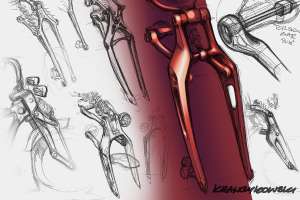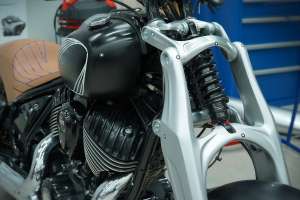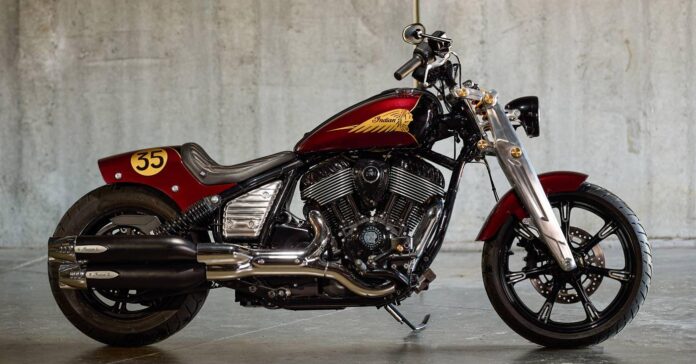Fresh off the plane from EICMA, Indian Motorcycle’s Director of Design, Ola Stenegärd, takes us behind the scenes of the Indian Girder Concept.
The recent sale of Indian Motorcycle by Polaris set the internet ablaze with speculation about the storied American marque’s future. But while the keyboard cowboys have been flapping their gums, the people inside the company have been quietly getting down to business.
Indian arrived at the annual EICMA trade show in Milan with a flurry of model updates for 2026, along with a particularly alluring concept motorcycle. Built on the bones of a Thunderstroke 116-powered Indian Chief, the Indian Concept Girder is a homage to the 1946 Indian Chief—the first Chief to wear a girder front end.

As implied, the bike’s main highlight is its elegantly sculpted girder fork. But there’s more at play here than just the front end—Indian fabricated a custom tail section to bookend the bike, with shades of the ‘Spirit of Munro’ Scout that the firm built eight years ago. In between, the Chief is festooned with a smorgasbord of bespoke and catalog parts.
Standout pieces include the vintage Flanders bars, machined side covers, and luxe leatherwork by Europe’s favorite upholsterer, Silver Machine. The design and execution were all handled in-house by Indian staffers Niclas Roch, Bartek Krawczykowski, and Jan-E Gustafsson.

Finished off in a livery that pays tribute to the legendary Burt Munro (complete with his number, 35), the Indian Concept Girder stood tall at the company’s stand at EICMA, sharing space with the Indian Challenger racing bagger that Tyler O’Hara piloted to a new land speed record earlier this year.
We caught up with our good friend and Indian Motorcycle’s Director of Design, Ola Stenegärd, just as he touched down in his homeland of Sweden after a frenetic visit to EICMA. The man was brimming with pride at what his team had achieved, and undeniably excited for Indian’s next chapter.

Bike EXIF: Ola, there’s been a lot of talk about Indian in the press lately—but how was the vibe at EICMA this year, on the ground?
Ola Stenegärd: It was so energizing to be at EICMA, because people were pumped! Actions are what count, which is why we thought it was mega important to make a statement with this bike.
BE: Your team has design studios in both the US and Europe—which one was responsible for the Girder Concept?
OS: We had both the Minneapolis and Swiss studios fully involved on Girder. Most projects are a fully collaborative effort. Many times, we even hand off stuff from one studio to the other overnight, so we really make the most out of these two locations. It’s like working shifts. It’s actually really cool. We use 3D printers and clay mills to mirror what we do between the studios.

BE: The team sounds pretty tight…
OS: We are a small team with floating, hybrid roles. Everyone’s voice matters because we are all bike builders and riders, as well as experienced designers, modelers, and engineers. Both Niclas and Jan are prize-winning custom and chopper builders on the highest level, which is really cool. We’re a tight crew and super synced.
BE: Why did you pick the 1946 Chief, specifically, as inspiration?
OS: The girder wasn’t invented by Indian, and also wasn’t new by any means when it was introduced on the Chief in 1946. Girder forks already made their bones with Indian on the Scout in both racing and on the road since the 1930s. Even the Chief-style girder debuted on the 841 during the war. But on the 1946 Chief, it all came together so nicely. It became such an iconic style statement for the Chief. And we wanted to put a spotlight on that. Plus, a girder is actually such a sound construction.

BE: The headlight looks like a custom bucket with Indian LED internals… am I correct?
OS: Nothing escapes your trained eye. Correct. And on that note, if you look at the headlight, you’ll see that it’s mounted to the triple trees, not the fork itself, which is an absolute must if you don’t want a light that bounces all over the place like a raccoon on meth. It’s something you’d know if you’ve ever ridden a chop or old bike with a traditional fork-mounted girder headlight. A small detail that most concepts with girder forks totally forget. But we wanted to keep it real, so Niclas and Bartek put a lot of effort into solving that puzzle.
BE: Are the wheels from the existing Indian catalogue?
OS: Yes—our Chief Bobber cast wheels. Also, the Stage 1 air cleaner and the mufflers come from our current accessory collection.

BE: The whole front end looks so clean and sculpted—was it CNC-machined or cast?
OS: We imagined it as a cast piece, because, again, we wanted to keep it real. Hence, the dimensions and the sculpted look. Bartek really sketched his heart out on all the beautiful detailing. But for the actual concept, it was all machined from billet.
The same goes for the side covers—another detail I absolutely love. I think we should offer those as accessories. I need them for my Chief, haha.

BE: What about the shock itself?
OS: The shock was custom-made to spec for this specific setup. The concept bike is put together to be a runner. So we wanted to make sure that it’s set up correctly.
BE: Does that mean we could see ideas from the Girder Concept make their way onto production bikes in the future?
OS: It’s a concept, but we wanted to keep it as real as possible. To be achievable and believable. But, for now, it’s a design study only.
Indian Motorcycle | Images by David Shelleny (studio) and Hermann Köpf (behind the scenes)

